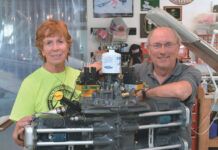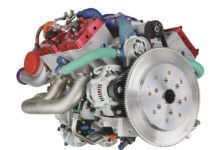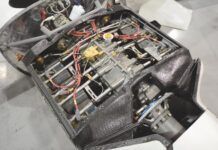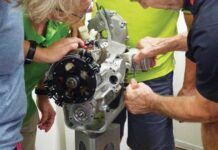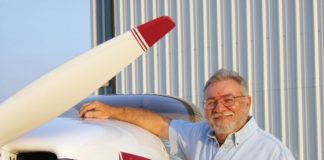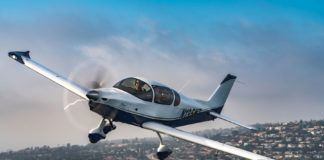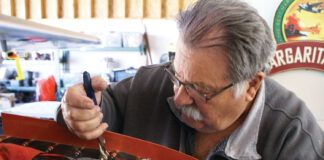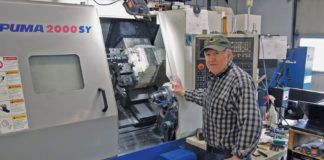KITPLANES Magazine, August 2001
Auto Engines for Aircraft
Part 2 of an engineering perspective on these popular conversions.
By Terry Edwards
Last month we covered some of the differences between engines designed for aircraft and those that might be converted from auto use. Topics included propellers and speed-reduction units, cooling and lubrication systems. This time we conclude with other systems that deserve careful attention when considering flight with an auto engine.
Sparking
Automobile ignition systems have progressed from points, condenser coil and distributor types, through solid-state switch systems, through integrated computer-controlled engine management systems. Modern engines will not run without all the sensors and controls, so when selecting a candidate engine, the ignition system should be included.
Factors that are not considered by automobile engine designers are radio frequency (RF) shielding and high-altitude operation. Modern engines are known to emit RF interference that can be picked up with a VHF radio. GPS systems are also sensitive to stray interference. The high-voltage portion of the system is the most susceptible to dielectric breakdown at high altitudes due to the lower air pressure. Aircraft engines have used sealed or pressurized magnetos to overcome this. Careful testing should reveal whether this is a problem.
Some redundancy should be incorporated into the ignition system. FAR 33.37 for certified engines requires dual spark plugs per cylinder, a dual ignition system, and two separate electric circuits with separate sources of electrical energy, or a system of equivalent in-flight reliability. While it may not be possible to have two spark plugs per cylinder due to cylinder-head design, other portions of the system can be made redundant.
The choice of fuel requires careful consideration. Table 1 illustrates the major differences between aviation and automotive gasolines.
|
Table 1. Comparing fuels. |
Avgas 100LL has a low and fixed vapor pressure all year to minimize vapor lock at all altitudes. Contrasting this, all grades of mogas vary the vapor pressure throughout the year to provide easy starting, but this leads to increased susceptibility to vapor locking. In addition, mogas absorbs more heat in the carburetor, leading to a greater susceptibility to carburetor icing.
The lead content of avgas is required to attain the octane (or anti-detonation) rating of 100. However, on lower-compression engines that do not need the octane rating, the lead content can cause lead fouling and erosion of spark plugs, valve erosion, and valve and ring sticking. In addition, lead is incompatible with catalytic converters and oxygen sensors used on modern automobile engines. While catalysts probably wouldn’t be used in an aircraft conversion, the oxygen sensors in the exhaust system are required for correct operation of the engine control computer.
In many areas of the country, alcohol is allowed in mogas. Alcohol may separate from the gasoline, and it will absorb water, which may freeze. Alcohol also attacks the elastomers used as seals in the fuel system. If using mogas, test for the presence of alcohol before filling the tanks. When designing the fuel system, conduct tests of the seals using the fuel chosen to ensure compatibility. This should include the fuel tank sealant, O-rings, face seals, carburetor jets and floats, fuel pump components, and fuel injection components.
With up to four mogas octane ratings available, it is important to use only the grade specified by the engine manufacturer. The use of lower octane ratings can cause detonation and engine failure.
Ice
Induction-system icing must be considered. With a carburetor, some form of carburetor heat must be used. This may be a diverter valve to direct induction air over the exhaust manifold similar to aircraft engines. If the engine is fuel injected, an alternate source of air is required in case the primary inlet becomes iced over.
Mounts
Engine mounts must be designed to support all of the flight loads encountered. The weight of the engine and propeller system, the load factors (positive and negative) that the airframe is designed for, and thrust provided by the propeller must be supported by the engine mount.
When analyzing the mounts, remember that the torque reaction of the engine may cause some members of a seemingly symmetrical mount to be in compression while the opposite member is in tension. Aircraft stressed for aerobatic use must consider propeller gyroscopic forces on the propeller shaft as well as the engine mounts as these may dominate the normal forces, particularly in snap maneuvers. Steel tubing is the preferred material as it can be welded to the full strength of the tube and because it is more heat- and fatigue-resistant than aluminum-sheet structures.
The mount should be designed on the space frame principle: Each tube is axially loaded in compression or tension. Each compression tube must be checked for buckling and have an adequate margin of buckling load to actual load. Transverse loads in the middle of tubes such as brackets for oil coolers and ECU modules must be avoided. If components must be mounted on the engine mount, the structure should be triangulated at that point and analyzed carefully.
Accessories
Automobile engines usually do not have sufficient accessory drives for aircraft applications. While some automobile engines have mechanically driven fuel pumps, none has a vacuum pump drive or propeller governor drive. For aircraft that require these drives, the method of driving requires careful consideration.
Probably the easiest way is to drive these from the propeller speed-reduction unit (PSRU), but most commercially available units have no provision for extra drive pads. These accessories may be driven by gears, belts or chains. V-belt drives are probably the easiest to add, similar to automotive alternator (and Lycoming alternator) drives. If this is done, the accessory manufacturer must be consulted to ensure the component will withstand the side load on the input shaft imposed by the V-belt.
Modern automobile alternators are very powerful, compact, light and reliable. However, an electrical load analysis should be done by adding all the aircraft equipment and engine ECU computer loads. Total load should be at least 20% less than capacity.
For redundancy, it is worth considering using two smaller alternators instead of one large one, especially if the engine is fitted with an ECU. Of course, they should have separate drives. Also, it is worth considering fitting dual batteries with isolation between the two electrical systems so a single malfunction does not cause an engine shutdown. All the major electrical components, alternator, voltage regulator (if separate), and the ECU must be supplied with cooling air. Nothing destroys electrical components faster than heat.
Brackets for the accessories are just as important as the accessory itself. An engine that fails because a bracket falls off fails just as surely as if the crankshaft broke. Brackets must be strong enough to manage the loads, stiff enough to not vibrate, and light enough so they do not impose a weight penalty. All the usual engineering principles apply.
Before Flying
Getting back to our engineering principles from the opening paragraph in Part 1 last month, the analysis and ground test of the finished engine installation is probably the most important element before committing to flight test. Strangely, this seems to be the most poorly done, but its importance cannot be overstated. There are two main aspects to this: power and reliability analysis and test, and vibration analysis and test.
Power and reliability should be verified using similar procedures to the certification requirements for aircraft engines. These are detailed in FAR 33.49 and prescribe a 150-hour endurance test differing in detail whether the engine is supercharged or not. This endurance test may be used as a guideline for automotive conversions, and the total time and detail tests may be shortened as desired.
If the engine passes this test, it should be disassembled and checked for wear and crack-tested. The valves should be inspected and relapped or reground. The valve guides should also be inspected.
Vibration analysis and measurement is probably the least understood and most important part of testing. Most builders understand that dynamic balancing of the rotating components, especially the pistons, rods, crank and propeller, results in smoother running. But realize that there are different grades of dynamic balancing. ISO 1940 lists 11 grades from crankshaft drives of large marine diesel engines to gyroscopes. The choice of grade should be discussed with the balancing shop and depends on the balancing equipment and the budget.
A Demonstration
Even an engine that is perfectly balanced dynamically will have torsional vibration due to the intermittent nature of the power production and transmission. A simple model to visualize torsional vibration can be made using a small-diameter steel wire (such as a piece of coat hanger wire about 12 inches long) suspended vertically with a weight (such as a gallon paint can) firmly attached. Rotate the weight about a quarter turn, release it, and watch the weight oscillate around the axis of the wire. Now, with the weight oscillating, turn the suspended end of the wire at a constant rotational speed.
This simulates a piston and connecting rod causing torsional vibrations in the rotating crankshaft. Of course, due to multiple cylinders, the frequency is much higher in an engine, and because the crankshaft, drive and propeller shaft are stiffer, the amplitude or amount of rotation is much lower.
If the amount of weight is kept the same but the shape is changed (a 2×4 piece of wood weighing the same as the paint can) and the experiment repeated, the wire would oscillate slower due to the higher rotational inertia. This simulates the propeller causing torsional vibrations in the propeller shaft. Notice that once excited, the torsional vibration continues for a long time because the wire has very little internal damping.
Engine Vibration
Many automobile engines have a torsional damper on the accessory drive end of the crankshaft. However, the entire drive train must be considered as a system in controlling torsional vibrations. An automobile drive train includes the engine, a clutch with damping springs for a manual transmission or a hydraulic torque converter, a transmission, driveshaft and wheels and tires.
Being made of rubber, the tires damp a lot of the torsional vibration. When the engine is converted for aircraft use, the entire drive train is removed, and a new one is substituted. The PSRU and the propeller both contribute torsional vibrations to the new system, and engine vibrations can be fed into the propeller and vice versa.
Once the engine, PSRU and propeller have been chosen, the mass elastic system is finalized except for torsional dampers. A mass elastic drawing is prepared that lists the mass moment of inertia (a property with the mass of the paint can in the simple model) of each major part such as pistons, crank and propeller – plus the torsional spring rate of the elements connecting the masses (a property of the coat hanger in the simple model). The mass elastic system is then analyzed by a specialized computer program to compute the natural frequencies of the elements in the system and the forcing frequencies (the input).
The critical frequency occurs when the forcing frequency coincides with the natural frequency. Critical frequencies should be computed with all cylinders firing and with one cylinder misfiring. If the system is operated at its critical frequency, it will fail in short order. If the system has inadequate margins between forcing and natural frequencies, it must be modified to include extra mass, extra elasticity or a torsional damper, or a barred speed range must be observed.
When the analysis proves the system has adequate margins, the engine should be run and tested to prove the analysis with electronic torsional-vibration recording equipment.
Failure to perform either the torsional vibration analysis or to test the engine system can result in spectacular failures of parts such as crankshafts or PSRU drives – or unspectacular but annoying failures such as jets backing out of carburetors, flywheel bolts loosening, and cam drives wearing prematurely. The world of certified engines is full of examples of newly designed engines or new propellers on old engines having torsional vibration failures. These are normally corrected during the certification process by the methods noted here.
Certified vs. Auto Engines
|
| Table 2. Comparing a 180-hp aircraft engine to two automobile-derived engines. |
Finally, we will directly compare a 180-hp aircraft engine to several automobile-derived industrial engines. In Table 2, notice the differences in weight and the specific weight between the engine types. Naturally aspirated aircraft engines typically weigh 2 pounds per horsepower. The auto/industrial engines in the table weigh 3-3.5 pounds per horsepower including the cooling system. Most aircraft weigh 10 pounds per horsepower, so the substitution of a heavier engine means the airframe must be lighter, or the payload must be reduced.
The normal rated power of the auto/industrial engine occurs at 3000 rpm, which is only about 10% above the aircraft engine rated speed. Therefore a PSRU is not really needed to drive the propeller. The V-6 is the lightest but has inadequate power at its normal rated power. If we compromise on longevity (lower TBO) by increasing the power and rpm, we can re-rate the engine to 190 hp at 5400 rpm. Then we need a PSRU of 2:1 ratio to reduce the propeller speed to 2700 rpm.
But the PSRU adds another 50 pounds, increasing the total weight to 478 pounds, and it is only 95% efficient, thereby consuming about 10 hp. Now we need to reduce the engine weight by 183 pounds to get it to the same weight as the aircraft engine. We can substitute an aluminum block and heads, but this adds cost. When the cost of all the components is known, a cost/ weight/power analysis should be performed to ensure the engine will have adequate performance for the intended airframe.
What Does It Mean?
In summary, an aircraft engine must be reliable and light with small bulk and good power-to-weight ratio. Successfully converting an automobile engine for aircraft use requires a good deal of engineering design, analysis and test. The hope is that the information in this two-part series serves as a guide for those who wish to embark on the quest of lower-cost aircraft engines.
AUTHOR TERRY EDWARDS is a senior mechanical design engineer currently working on marine propulsion drives. He flies his own airplane and is working on the Canadian equivalent of an A&P mechanic’s rating.






